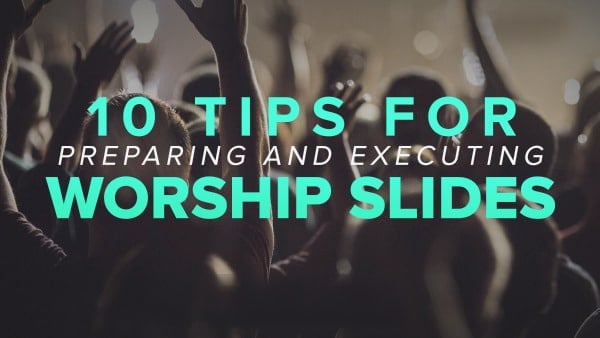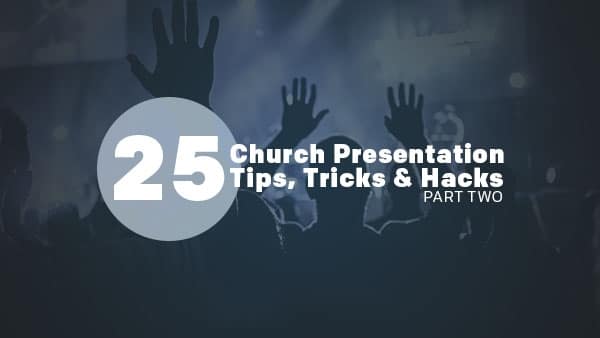
Leading Lyrics in Worship: The How
Leading lyrics, the practice of transitioning slides ahead of the time they need to be sung, is an important part of corporate worship in our churches today. In my previous blog, I explained why this is so important. And in this blog, I will be explaining how to actually lead lyrics.
HOW DO WE LEAD LYRICS IN OUR PRESENTATIONS?
The how is a multiple part answer.
The first thing I would say is key, is to know the music. When I say knowing the music that means knowing it well enough to know what comes next. We need to know the music well enough that we can transition before lyrics are needed to sing the next part. So know the music for your service well. Have a plan for what is going to happen. This doesn’t mean that the plan can’t ever change but be prepared for what worship songs you are doing. If you put no time and preparation into learning the worship songs, this will result in your following the worship team and in turn being behind. Knowing the music and being ready to pay attention to the body language of people on stage sets you up for an excellent leading worship time.
The beauty of this practice is that it doesn’t matter which software you use to show lyrics in your church. Regardless, you need know the music and you need to lead the lyrics.
Suggested Tweet: "We need to know the music well enough that we can transition before lyrics are needed to sing the next part of the song. @stevodirks"
The second key for me is to transition on the second to last word (or sometimes on the the end of the 3rd word if it is a really fast song and depending on your slide format). If you follow this rule you will find yourself ahead of when people need to sing the next slide (to help in this, you may need to decrease the transition time between slides or change them to a “cut” transition).
Now as you are running a service your tendency will be to drift to the last word or try to time with the music exactly. Unless you have made specific notes about different slides and their transitions in the music, stick to this rule. It’s always better in my opinion to be a little ahead, which allows people to know what is next, instead of being behind, which results in people not knowing what to do
The third key of the how to lead in lyric presentation is to take time to prepare for Sunday Worship. For my church, we have rehearsals where we record the practice so we can go back and listen, make edits, and check the format of our Sunday worship songs every week. For some of you that isn’t an option and I understand that. The best way to be prepared is to be vigilant and ready for any rehearsal time you get. If you only get a Sunday morning rehearsal, then be ready and locked in to make the most of the time you get. Listen, pay attention, and make notes about the form or band notes about changes to the music they plan to make. If you just see yourself as a button pusher you will find yourself behind. If you see yourself as a part of the worship team, tasked with leading your church in worship, you will know the music, make changes, and be prepared for anything.
Suggested Tweet: "Don't see yourself as a button pusher, but as a part of the worship team, tasked with leading the church in worship, through displaying lyrics. @stevodirks"
The next key takes some practice because you don’t want to focus on this while missing lyrics slide transitions.
The fourth key is watching people on stage for visual cues. At my church, for our Modern worship service we rely heavily on GUIDES (guides are built into our tracks and give audible cues of where we are in a given song, i.e. “verse 1” “chorus” “outro”). These are so helpful for coming out of instrumentals, intros, pauses, and endings. These cues will help you know what is coming next and set up your lyrics accordingly.
If you don’t have this “luxury” I would encourage you to watch your worship leader or worship team singing. This requires you to know what is going on in the lyric program and be able to glance at the stage for these visual cues. For instance, when leaders are getting ready to sing will raise a mic up to the mouth (this is a good cue to start the first slide). This same trick applies for coming out of instrumentals. Use visual cues on stage to help you know when stuff is going to happen. I have found that as I have locked in and paid attention to not only what I am hearing but also visual cues they give me as they sing I am able to confidently serve and prepare to help lead in worship with the musical team.
Bonus Tip: An extra tip for dealing with change, is to organize your song content in a way that you know the different parts. You should know where the verses, choruses, and bridges are located. Doing this will help you to respond quickly to any changes that might come your way and get back to leading with your lyrics.
WHAT FACTORS CAN HELP OR HINDER US?
The factors I feel that help me lead with my lyrics are
1. being prepared by listening to the music (multiple times) both during the week and on the weekend before the services
2. prepping during the week during practice time to ensure our slides are formatted as we plan to do the music
3. knowing the parts of the songs so that I can adapt as needed, and transition at the right time
The things I have found that hurt us in leading lyrics are
1. not spending time on the music during the week, before Sunday
2. running late (plan to be prepared and early for Sunday morning so you aren’t surprised)
3. getting lost in the slides, and not staying engaged from countdown to post service (our tendency at times in our services can be to come in and out of engagement and this can allow us to become situationally unaware of what is happening then we become reactive instead of proactive)
Suggested Tweet: "I always preach to stay engaged, alert, prepared, and situationally aware for the whole service and I believe the people in your church will see the difference. @stevodirks"




